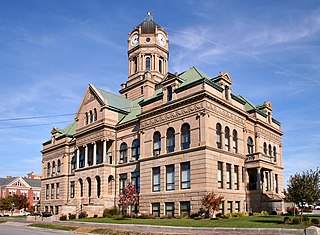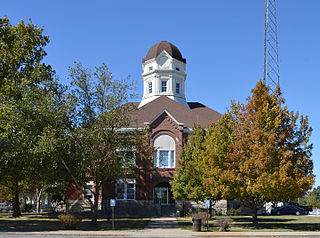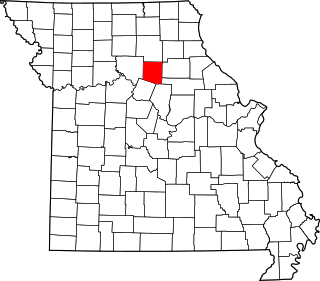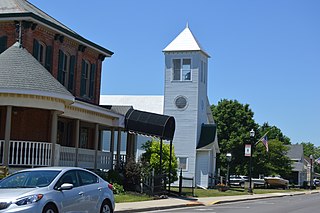
Montgomery County is in the southwestern part of the U.S. state of Ohio. At the 2020 census, the population was 537,309, making it the fifth-most populous county in Ohio. The county seat is Dayton. The county was named in honor of Richard Montgomery, an American Revolutionary War general, who was killed in 1775 while attempting to capture Quebec City, Canada. Montgomery County is part of the Dayton, Ohio, Metropolitan Statistical Area.

Randolph County is a county on the central eastern border of the U.S. state of Alabama. As of the 2020 census, the population was 21,967. Its county seat is Wedowee. Its name is in honor of John Randolph, a member of the United States Senate from Virginia. Randolph County was a prohibition or dry county until 2012, when the citizens of Randolph County voted to repeal prohibition.

Upshur County is a county in the U.S. state of West Virginia. As of the 2020 census, the population was 23,816. Its county seat is Buckhannon. The county was formed in 1851 from Randolph, Barbour, and Lewis counties and named for Abel Parker Upshur, a distinguished statesman and jurist of Virginia. Upshur served as United States Secretary of State and Secretary of the Navy under President John Tyler.

Miami County is a county located in the U.S. state of Ohio. As of the 2020 census, the population was 108,774. Its county seat is Troy. The county is named in honor of the Miami people.

Mercer County is located in the U.S. state of Ohio. As of the 2020 census, the population was 42,528. Its county seat is Celina. The county was created in 1820 and later organized in 1824. It is named for Hugh Mercer, an officer in the American Revolutionary War.

Harrison County is a county located in the U.S. state of Ohio. As of the 2020 census, the population was 14,483, making it the fifth-least populous county in Ohio. Its county seat and largest village is Cadiz. The county is named for General William Henry Harrison, who was later President of the United States.

Gallia County is a county located in the U.S. state of Ohio. As of the 2020 census, the population was 29,220. Its county seat and largest village is Gallipolis.

Darke County is a county in the U.S. state of Ohio. As of the 2020 census, the population was 51,881. Its county seat and largest city is Greenville. The county was created in 1809 and later organized in 1817. It is named for William Darke, an officer in the American Revolutionary War. Darke County comprises the Greenville, OH Micropolitan Statistical Area, which is also included in the Dayton-Springfield-Sidney, OH Combined Statistical Area.

Champaign County is a county located in the U.S. state of Ohio. As of the 2020 census, the population was 38,714. Its county seat and largest city is Urbana. The county takes its name from the French word for "open level country". Champaign County became the 18th of 88 Ohio counties on March 1, 1805. It was formed from parts of Greene and Franklin counties by legislative action.

Auglaize County is a county in Northwestern Ohio, United States of America. As of the 2020 census, the population was 46,442. Its county seat and largest city is Wapakoneta. Auglaize County comprises the Wapakoneta Micropolitan Statistical Area, which is also included in the Lima-Van Wert-Celina Combined Statistical Area.

Toole County is a county in the northern portion of the U.S. state of Montana. As of the 2020 census, the population was 4,971. Its county seat is Shelby. The county was established in 1914 from parts of Hill County and Teton County and was named after Joseph Toole, the first and fourth governor of Montana. Its northern boundary is the Canada–United States border south of Alberta.

Shelby County is a county located in the northeastern portion of the U.S. state of Missouri. As of the 2020 census, the population was 6,103. Its county seat is Shelbyville. The county was established on January 2, 1835, and named for Governor Isaac Shelby of Kentucky.

Randolph County is a county in the northern portion of the U.S. state of Missouri. As of the 2020 census, the population was 24,716. Its county seat is Huntsville. The county was organized January 22, 1829, and named for U.S. Representative and U.S. Senator John Randolph of Roanoke, Virginia.

Ripley is a village in Union Township, Brown County, Ohio, United States, along the Ohio River 50 miles southeast of Cincinnati. The population was 1,591 at the 2020 census.

Piqua is a city in Miami County, Ohio, United States, along the Great Miami River. The population was 20,354 at the 2020 census. Located 27 miles (43 km) north of Dayton, it is part of the Dayton metropolitan area.

Anna is a village in Shelby County, Ohio, United States. The population was 1,470 at the 2020 census.

Fort Loramie is a village in Shelby County, Ohio, United States, along Loramie Creek, a tributary of the Great Miami River in southwestern Ohio. It is 42 mi. north-northwest of Dayton and 20 mi. east of the Ohio/Indiana border. The population was 1,590 at the 2020 census. The village was founded in 1837 near the former site of a colonial fort of the same name.

Jackson Center is a village in Shelby County, Ohio, United States. The population was 1,441 at the 2020 census.

Lockington is a village in Washington Township, Shelby County, Ohio, United States, along Loramie Creek. The population was 162 at the 2020 census.

Sidney is a city in and the county seat of Shelby County, Ohio, United States, located approximately 36 miles (58 km) north of Dayton and 100 miles (160 km) south of Toledo. The population was 20,421 at the time of the 2020 census. It is named after English poet Philip Sidney, and many of the city's elementary schools are named after famous writers, including Ralph Waldo Emerson, Henry Wadsworth Longfellow, and John Greenleaf Whittier. Sidney was the recipient of the 1964 All-America City Award. In 2009, it was the subject of the documentary film 45365.



























